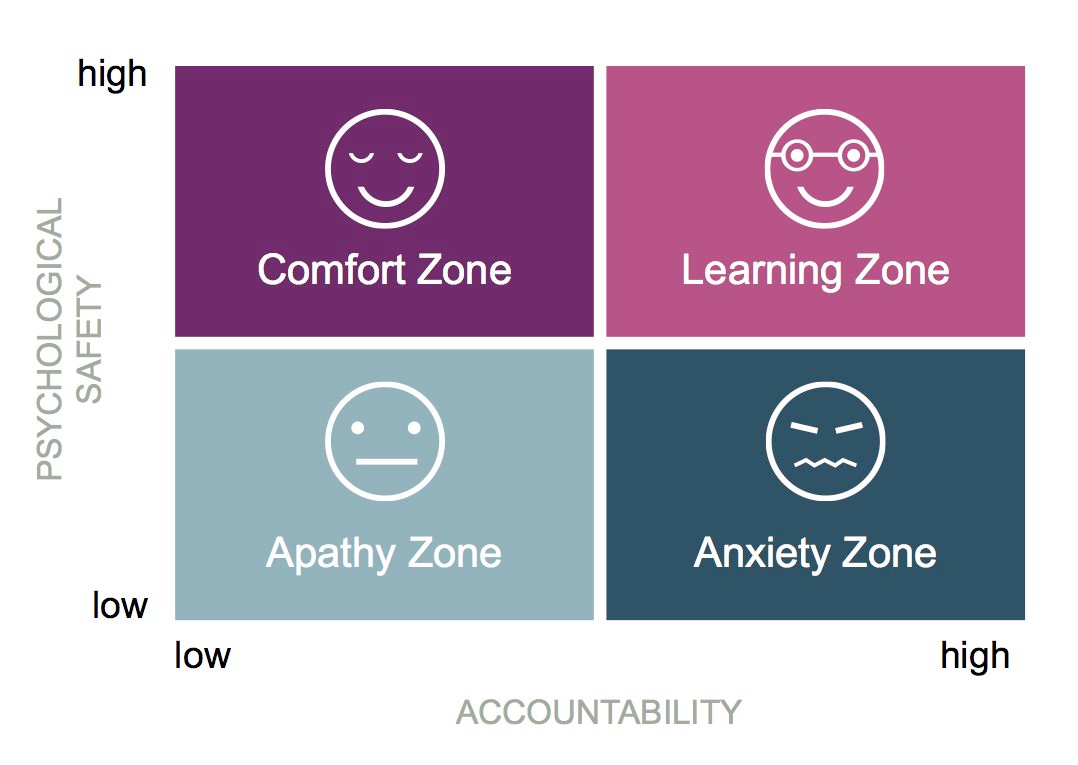Psychological safety
Openscapes Champions Program
CC-BY Openscapes
Last updated 2023-04
Overview
❓ What is psychological safety?
⚙️ Why is psychological safety important?
📈 How can I boost psychological safety on my team?
What is psychological safety ❓
Amy Edmondson (Harvard Business School) says (1999)…
Emphasis added.
The shared belief held by members of a team that the team is safe for interpersonal risk taking
A sense of confidence that the team will not embarrass, reject or punish someone for speaking up
🚫 avoiding conflict or being “too nice”
✅ kind and honest communication
Examples

Images sourced from Wikimedia Commons (CC-BY), and altered (1, 2)
⚙️ Why is psychological safety important?
Risks & consequences
Not having psychological safety considered harmful

Edmondson (2014), TEDx talk
Optimize team learning & effectiveness

Edmondson (2014), TEDx talk. The “learning zone” is when psychological safety and accountability are high.
📈 Actions to boost psychological safety on your team
🚫 Avoid behaviors that punish risk taking
✅ Encourage risk-taking
😖 Acknowledge when we make mistakes
🚫 Avoid punishing risk-taking
Overcompensate for tone (2014)
\[🤪 \in 💼\]
🤏😎
🤏🕶️🤨We need to talk!
🤩 We need to talk!
✅ Encourage risk-taking
- Framing work as a learning problem, not an execution problem! (Edmondson 2014)
- Model curiosity
It takes time and consistency to build trust
It’s OK to repeat yourself!
All ideas are valuable
Woops! I made a mistake
There are no “stupid questions”
Our job is to learn
😖 Acknowledge our mistakes
Ask yourself and your team:
What am I missing here?
What haven’t I considered?
📈 Actions to boost psychological safety on your team
🚫 Avoid behaviors that punish risk taking
✅ Encourage risk-taking
😖 Acknowledge when we make mistakes
Thank you! ❤️
Thought exercise
What is something that you or someone has done on a team to make it psychologically safe to speak up with a wildly creative idea or a problem that no one else saw?
🎉 Bonus slides
Assess
Use Amy Edmondson’s 7-item assessment:
- If you make a mistake on this team, it is not held against you.
- Members of this team are able to bring up problems and tough issues.
- People on this team sometimes accept others for being different.
- It is safe to take a risk on this team.
- It isn’t difficult to ask other members of this team for help.
- No one on this team would deliberately act in a way that undermines my efforts.
- Working with members of this team, my unique skills and talents are valued and utilized.
Learn more
Please visit our learn more page, where we’ve collected some additional resources.
🚧 Construction zone 🚧
Continue to end to see our references!
How Gavin Fay makes a psychologically safe space
From Gavin’s 2022 NOAA seminar Q&A:
- Live coding, show mistakes
- Prioritize time to get to know each other & share interests
- “What birds did you see this weekend?”
- Follow pedagogical approaches to onboarding more inclusively
- Ex: teaching R with the tidyverse
- TODO: Why is this a good example?
- Ex: teaching R with the tidyverse
TODO: This story?
On June 23, 2019, a landslide in a remote and rugged canyon along the Fraser River, north of Lillooet, was reported to the B.C. government. Over 85,000 cubic metres of rock had sheared off a 125-metre-high cliff and fallen into the river. These huge pieces of rock created a five-metre waterfall, which trapped migrating salmon below the slide. https://www2.gov.bc.ca/gov/content/environment/plants-animals-ecosystems/fish/aquatic-habitat-management/fish-passage/big-bar-landslide-incident
🔧 TODO
- Leslie Miley - the Ketchup Test: https://gimletmedia.com/shows/reply-all/76h54l
- Add as a reference, add a dedicated slide?
- In Amy’s TED talk she mentions this towards the 10 minute mark IIRC, in emphasizing that this is critical for teams dealing with complexity and interdependency (i.e. most science work) but a mere cherry on top for teams that don’t have those challenges._
